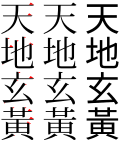Sans serif
| Sans-serif font | |

|
Serif font |

|
Serif font (serifs in red) |
In typography, a sans serif typeface is one that does not have the tiny feet called "serifs" at the end of strokes.[1] The term comes from the French word sans, meaning "without" and "serif" from the Dutch word schreef meaning "line".
Sans serif typefaces have been used since the 18th century, but became most used in the twentieth century as the modern art movement developed. Most designers of typefaces were artists. Some were outstanding in other artistic fields, and were part of the wider artistic culture of their times.[2]
The apostle of sans serif was Jan Tschichold (2 April 1902 Leipzig, Germany – 11 August 1974 Locarno, Switzerland), a German-Swiss graphic designer.[3][4][5] Tschichold not only designed typefaces, he showed how they could be used in the design of book printing. He was a chief designer for Penguin Books after the Second World War.[6]
Sans serif faces are most used for display signs, advertising and for headings in books. Although they seem to work well for the text in books, they are much less used for that purpose.
Other names for sans serif
- Egyptian
- Antique
- Grotesque
- Doric
- Gothic (not to be confused with blackletter)
- Lineale, or linear
- Simplices
- Swiss
Sans Serif Media
From left to right: a Ming serif typeface with serifs in red, a Ming serif typeface and an East Asian gothic sans-serif typeface
Akzidenz-Grotesk, originally released by H. Berthold AG in the 1890s. A popular German grotesque with a single-story 'g'[a]
Helvetica, originally released by Haas Type Foundry (as Neue Haas Grotesk) in 1957. A typical neo-grotesque.
Futura, originally released by Bauer Type Foundry in 1927. A typical geometric sans-serif
Syntax, originally released by D. Stempel AG in 1969. A humanist sans-serif
References
- ↑ "sans serif" in The New Encyclopaedia Britannica. Chicago: Encyclopaedia Britannica Inc. 15th edn., 1992, Vol. 10, p. 421.
- ↑ Gottschall, Edward M. 1989. Typographic communications today. MIT Press, Cambridge, Mass. and London. ISBN 0-262-07114-2
- ↑ Tschichold, Jan 1928. Die neue Typographie, Ein Handbuch für zeitgemäss Schaffende. Berlin, Verlag des Bildungsverbandes der Deutschen Buchdrucker.
- ↑ Tschichold, Jan 1967. Asymmetric typography. Faber & Faber.
- ↑ McLean, Ruari 1997. Jan Tschichold: a life in typography. Princeton Architectural Press. ISBN 1-56898-084-1.
- ↑ Doubleday, Richard B. 2006. Jan Tschichold, Designer: the Penguin years. Oak Knoll Press & Lund Humphries ISBN 978-1-58456-178-1; ISBN 1-58456-178-5
Cite error: There are <ref> tags on this page, but the references will not show without a {{Reflist|group=lower-alpha}} template or a <references group="lower-alpha"/> tag.







